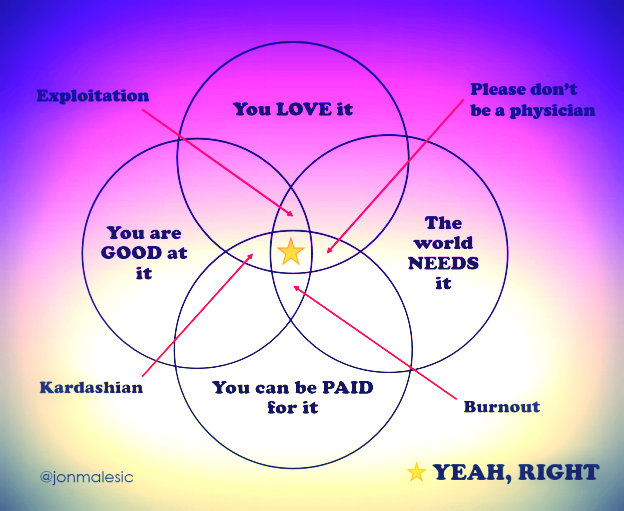Last week, the interwebs were abuzz with reactions to the most recent attempt to conceptually delineate the generation-formerly-known-as-Y: the “yuccie.” A rather unpalatable term to be sure, the “yuccie” is an acronym for Young, Urban, Creatives; its Reagan-era ancestor, the yuppie, is but a specter of these self-enterprising, digitally networked, creative aspirants. Mashable contributor (and self-identified yuccie) David Infante defined the post-hipster prototype as one “borne of suburban comfort, indoctrinated with the transcendent power of education, and infected by the conviction that not only do we deserve to pursue our dreams; we should profit from them.” Infante explained how yuccies are driven by the well-worn ideals of career passion and getting paid to do what you love.
In the wake of Infante’s piece, which was both a treatise of and self-reflective indulgence in the yuccie ethos, traditional media sources—including Time, CNN, and the New York Daily News—weighed in. And true to form, Buzzfeed offered a witty list of “99 Things All Yuccies Love,” including “creating their own vacation hashtag on Instagram,” “not understanding how someone could live without Amazon Prime,” and “#TBT.”
Market-driven categorizations such as “yuccie” are inherently ‘problematic’ (a word, incidentally, which appears as #19 on the aforementioned Buzzfeed list). They are expressions of what Joseph Turow described as the industrial construction of the audience, wherein commercial segmentation practices reify existing social divisions.[i] Of course, yuccies are not primarily defined by their consumer potential (though we can imagine advertisers working feverishly on pitches for clients seeking to reach the “yet-untapped yuccie market!”), but, rather, as future producers eager to join the ranks of the creative workforce. Infante offers a few yuccie career exemplars: “social consultants coordinating #sponsored Instagram campaigns for lifestyle brands,” brogrammers, and legions of entrepreneurial-minded twenty-somethings seduced by the potential offerings of the “internet playground.” Above all, then, the yuccie is defined by her labor—or, perhaps more accurately, her unwavering quest to secure a purposeful, profitable form of work.
Several years ago, the voguish (and similarly discordant) term for the idealized creative worker was “slashie,” named for a worker identity that spans several professions (e.g., banker/artist/etsy shop owner). The archetypical slashie is the financially secure analyst or lawyer who escapes the banality of her “day job” with a D.J. gig or freelance work as a muralist. Media coverage, not surprisingly, glorifies the “slashie” lifestyle; as an English tutor/theatre director told a London Evening Standard reporter, “I’m lucky because it doesn’t feel like work, it’s creative and it’s enterprising.” Such narratives construct an idealized model of cultural work, where labor and leisure blend in perfect harmony.
The problem, of course, is that labor and leisure aren’t harmonized–not for most cultural workers, at least. Media trend pieces, by pairing passion with (worker) profit, glamorize labor conditions that are far less remunerative and gratifying than hyped. We may conclude that such discourses represent an industrial valorization of multi-skilled, always-on, digitally networked creative worker.
As part of a book project on gendered social media labor, I’ve spent the last few years studying a particular subset of aspiring creative producers: fashion bloggers, beauty vloggers, and DIY artists/designers. While a handful of my interviewees emphasize the benefits of flexibility and autonomy that characterize the new media workstyle,[ii] many of these young women have drawn attention to the less glamorous aspects: demanding hours, a frenetic pace, high barriers to entry, multi-skilled work patterns, and the expectation from commercial brands that they will work for exposure rather than for financial compensation. And given that social media metrics are the currency animating the digital economy, participants engage in largely unpaid relational labor as they try to build networks and grow their friends/followers/likes.[iii] As one fashion blogging aspirant shared, “There are times where I’m up until two o’clock in the morning blogging and making sure everything looks perfect, and that all my posts are scheduled in a timely fashion.”
My research has also highlighted the significance of social class in structuring the hierarchies of the aspirational labor market. Often, those who are especially successful at channeling their passion projects into lucrative digital media careers come from a position of relative privilege—by virtue of economic and/or social capital. Class markers are central to constructions of “yuccies” and “slashies,” a fact not lost on Infante, who concedes that “yuccies possess enormous privilege.” Similarly, high-profile members of the “slash generation” hold down multiple jobs not because they need to, but for self-actualization purposes.[iv] The playing field for those seeking much-vaunted creative careers is thus anything but even.
But for the media, creative, and technology industries looking for talent in an oversatured labor market, this uneven playing field acts as a built-in employability filter: those who identify with the yuccie/slashie lifestyle represent the ideal worker for the digital economy. They are disciplined, entrepreneurial, and can invest resources in their own training (whether gleaned through unpaid internships or personal brand-building courses, which are now being offered at various universities). Above all, they embody the structures and practices of individualization.[v]
To employers, the benefits of this constructed worker subjectivity are manifold: they seek self-actualization rather than competitive pay; they save on labor expenses through the culture of BYOD (bring your own device). And if you provide them with an über-hip workspace (think Googleplex or any of these), they may share images of corporate”workspace porn” with their social media networks: #funoffice #workspaces #lovemyjob
In the end, while social constructions of audiences remain central to the mechanics of the consumer marketplace, the logic of the digital economy relies on the industrial construction of the model worker. The discourse of “yuccies” and “slashies” (e.g., personal fulfillment from a creative career) ensures that aspiring creators toil in exchange for autonomy, excitement, and ubiquitous access to technology–though not necessarily adequate compensation.
Author note: Many thanks to Jeff Pooley for his comments on an earlier version of this argument.
[i] Turow, J. (2007). Breaking up America: Advertisers and the new media world. Chicago, IL: University of Chicago Press. See also, Sender, K. (2004). Business, not politics: The making of the gay market. New York: Columbia University Press; Ang, I. (2006). Desperately seeking the audience. New York: Routledge. I also want to signal Lizabeth Cohen’s richly detailed history of postwar American consumerism, which explores how the evolution of market segmentation shaped political identities such that consumerism got rerouted as citizenship
[ii] Gill, R. (2010). Life is a pitch: Managing the self in new media work. In M. Deuze (Ed.), Managing Media Work (pp. 249-262). London: Sage; McRobbie, A. (2002). Clubs to companies: notes on the decline of political culture in speeded up creative worlds. Cultural Studies, 16(4), 516-531; Neff, G., Wissinger, E., & Zukin, S. (2005). Entrepreneurial labor among cultural producers : “Cool” jobs in “hot” industries. Social Semiotics, 15(3), 307–334; Neff, G. (2012) Venture labor: Work and the burden of risk in innovative industries. Cambridge, MA: MIT Press.
[iii] Baym, N. K. (2015). Connect With Your Audience! The Relational Labor of Connection. The Communication Review, 18(1), 14-22. For a discussion of the culture of reciprocity among fashion bloggers, see Duffy, B. E. (2014). Link love and comment karma: Norms and politics of evaluation in the fashion blogosphere. In H. C. Suhr (Ed.) Online evaluation of creativity and the arts, New York: Routledge.
[iv] The first appearance of the term was a 2008 piece by The Future Laboratory. See: http://almostalwaysthinking.com/2008/05/16/work-slash-creative-lifestyle/
[v] In her article “Clubs to Companies,” McRobbie (2002) draws on Beck (2000) and Bauman (2000) to explain how individualization is less about individuals and more about the fact “that people increasingly have to become their own micro-structures, they have to do the work of structures by themselves, which in turn requires intensive practices of self-monitoring or ‘reflexivity.” (page 518). See also, Neff, 2012.



